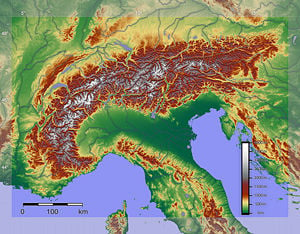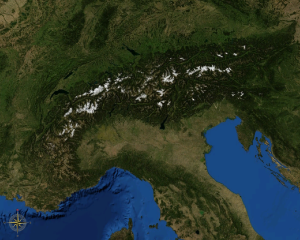Alps
- This article is about the Alps in Europe. For other uses of the term, see Alps (disambiguation).
The Alps (German: Alpen; French: Alpes; Italian: Alpi; Slovenian: Alpe) is the name for one of the great mountain range systems of Europe, stretching from Austria and Slovenia in the east, through Italy, Switzerland, Liechtenstein and Germany to France in the west. The word "Alps" was taken via French from Latin Alpes (meaning "the Alps"), which may be influenced by the Latin words albus (white) or altus (high) or more likely a Latin rendering of a Celtic original.
The highest mountain in the Alps is Mont Blanc, at 4,808 metres (15,774 ft), on the French-Italian border. All the main peaks of the Alps can be found in the list of mountains of the Alps and list of Alpine peaks by prominence.
Geography
Subdivision
The Alps are generally divided into the Western Alps and the Eastern Alps. The division is along the line between Lake Constance and Lake Como, following the Rhine. The Western Alps are higher, but their central chain is shorter and curved; they are located in Italy, France and Switzerland. The Eastern Alps (main ridge system elongated and broad) belong to Austria, Germany, Italy, Liechtenstein, Slovenia and Switzerland. The highest peaks of the Western Alps are Mont Blanc, 4,808 m (15,774 ft), Mont Blanc de Courmayeur 4,748 m (15,577 ft), the Dufourspitze 4,634 m (15,203 ft) and the other summits of the Monte Rosa group, and the Dom, 4,545 m (14,911 ft). The highest peak in the Eastern Alps is Piz Bernina, 4,049 m (13,284 ft).
The Eastern Alps are commonly subdivided according to the different lithology (rock composition) of the more central parts of the Alps and the groups at its northern and southern fringes:
- Flysch zone (from the Wienerwald to Bregenzerwald). Geographically, the Jura mountains do not belong to the Alps; geologically, however, they do.
- Northern Limestone Alps, peaks up to 3,000 metres (9,850 ft)
- Central Eastern Alps (Austria, Switzerland), peaks up to 4,050 metres (13,290 ft)
- Southern Limestone Alps.
The border between the Central Alps and the Southern Limestone Alps is the Periadriatic Seam. The Northern Limestone Alps are separated from the Central Eastern Alps by the Grauwacken Zone.
The Western Alps are commonly subdivided with respect to geography:
- Ligurian Alps
- Maritime Alps
- Cottian Alps
- Dauphiné Alps
- Graian Alps
- Pennine Alps
- Bernese Alps
- Lepontine Alps
- Glarus Alps
- North-Eastern Swiss Alps.
Series of lower mountain ranges run parallel to the main chain of the Alps, including the French Prealps. (See Alpine geography.)
The geologic subdivision is different and makes no difference between the Western and Eastern Alps: Helveticum in the north, Penninicum and Austroalpine system in the centre and south of the Periadriatic seam the Southern Alpine system and parts of the Dinarides (see Alpine Geology).
Main chain
The "main chain of the Alps" follows the watershed from the Mediterranean Sea to the Wienerwald, passing over many of the highest and most famous peaks in the Alps. From the Colle di Cadibona to Col de Tende it runs westwards, before turning to the north-west and then, near the Colle della Maddalena, to the north. Upon reaching the Swiss border, the line of the main chain heads approximately east-north-east, a heading it follows until its end near Vienna.
Principal passes
The Alps do not form an impassable barrier; they have been traversed for war and commerce, and later by pilgrims, students and tourists. Crossing places by road, train or foot are called passes. These are depressions in the mountains to which a valley leads from the plains and hilly pre-mountainous zones.
Climate
The Alps are a classic example of what happens when a temperate area at lower altitude gives way to higher elevation terrain. Elevations around the world which have cold climates similar to those found in polar areas have been called alpine. A rise from sea level into the upper regions of the atmosphere causes the temperature to decrease. The effect of mountain chains on prevailing winds is to carry warm air belonging to the lower region into an upper zone, where it expands in volume at the cost of a proportionate loss of heat, often accompanied by the precipitation of moisture in the form of snow or rain.
Geology
The Alps arose as a result of the pressure exerted on sediments of the Tethys Ocean basin as its Mesozoic and early Cenozoic strata were pushed against the stable Eurasian landmass by the northward-moving African landmass. Most of this occurred during the Oligocene and Miocene epochs. The pressure formed great recumbent folds, or nappes, that rose out of what had become the Tethys Sea and pushed northward, often breaking and sliding one over the other to form gigantic thrust faults. Crystalline rocks, which are exposed in the higher central regions, are the rocks forming Mont Blanc, the Matterhorn, and high peaks in the Pennine Alps and Hohe Tauern.
The landscape seen today is mostly formed by glaciation during the past two million years. At least five ice ages have done much to change the region, scooping out the lakes and rounding off the limestone hills along the northern border. Glaciers have been retreating during the past 10,000 years, leaving large granite erratics scattered in the forests in the region. As the last ice age ended, it is believed that the climate changed so rapidly that the glaciers retreated back into the mountains in a span of about 200 to 300 years.
Political history
Little is known of the early dwellers in the Alps, save from the scanty accounts preserved by Roman and Greek historians and geographers. A few details have come down to us of the conquest of many of the Alpine tribes by Augustus.
The successive emigration and occupation of the Alpine region by various Teutonic tribes from the 5th to the 6th centuries are known only in outline, because to them, as to the Frankish kings and emperors, the Alps offered a route to other places rather than a permanent residence.
It is not until the final breakup of the Carolingian Empire in the 10th and 11th centuries that it becomes possible to trace out the local history of the Alps.
Exploration
The higher regions of the Alps were long left to the exclusive attention of the people of the adjoining valleys, even when Alpine travellers (as distinguished from Alpine climbers) began to visit these valleys. The two men who first explored the regions of ice and snow were H.B. de Saussure (1740-1799) in the Pennine Alps, and the Benedictine monk of Disentis, Placidus a Spescha (1752-1833), most of whose ascents were made before 1806, in the valleys at the sources of the Rhine.
Flora
A natural vegetation limit with altitude is given by the presence of the chief deciduous trees — oak, beech, ash and sycamore maple. These do not reach exactly to the same elevation, nor are they often found growing together; but their upper limit corresponds accurately enough to the change from a temperate to a colder climate that is further proved by a change in the wild herbaceous vegetation. This limit usually lies about 1,200 metres (3,940 ft) above the sea on the north side of the Alps, but on the southern slopes it often rises to 1,500 metres (4,920 ft), sometimes even to 1,700 metres (5,580 ft).
This region is not always marked by the presence of the characteristic trees. Human interference has nearly exterminated them in many areas, and, except for the beech forests of the Austrian Alps, forests of deciduous trees are rarely found. In many districts where such woods once existed, they have been replaced by the Scots pine and Norway spruce, which are less sensitive to the ravages of goats, who are the worst enemies of such trees. The mean annual temperature of this region differs little from that of the British Islands; but climatic conditions are widely different. In the Alps, snow usually stays for several months, until spring and summer, which are considerably warmer on average than those seasons in Britain.
Above the forestry, there is often a band of short pine trees (Pinus mugo), which is in turn superseded by dwarf shrubs, typically Rhododendron ferrugineum (on acid soils) or Rhododendron hirsutum (on basic soils). Above this is the alpine meadow, and even higher, the vegetation becomes more and more sparse. At these higher altitudes, the plants tend to form isolated cushions. In the Alps, several species of flowering plants have been recorded above 4,000 metres (13,125 ft), including Ranunculus glacialis, Androsace alpina and Saxifraga biflora.
- Kosodrzewina (Sosna górska) Pinus mugo mugo.jpg
mountain pine
(Pinus mugo) - Rhododendron ferrugineum.JPG
rusty-leaved Alpenrose
(Rhododendron ferrugineum) - Leontopodium alpinum1.jpg
Edelweiss
(Leontopodium alpinum) - Gentiana acaulis.jpg
stemless gentian
(Gentiana acaulis) - Chamorchis alpina 230705b.jpg
Alpine dwarf orchid
(Chamorchis alpina) - Pulsatilla alpina schneebergensis.jpg
Alpine pasque-flower
(Pulsatilla alpina) - Androsace alpina02.jpg
Alpine rock-jasmine (Androsace alpina)
Fauna
Species common to the Alps. These are most numerously found in the 15% of the Alps protected in parks and reserves.
- Ptarmigan9.jpg
Ptarmigan - Aegolius-funereus-001.jpg
Tengmalm's Owl - Iiiiibed.jpg
Alpine Ibex - Arctic Hare.jpg
Mountain Hare
See also
- Alpinism
- Almabtrieb
- List of mountains of the Alps
- List of natural parks in the Alps
- Paganism in the Eastern Alps
Notes
ReferencesISBN links support NWE through referral fees
External links
All links Retrieved April 21, 2008.
Credits
New World Encyclopedia writers and editors rewrote and completed the Wikipedia article in accordance with New World Encyclopedia standards. This article abides by terms of the Creative Commons CC-by-sa 3.0 License (CC-by-sa), which may be used and disseminated with proper attribution. Credit is due under the terms of this license that can reference both the New World Encyclopedia contributors and the selfless volunteer contributors of the Wikimedia Foundation. To cite this article click here for a list of acceptable citing formats.The history of earlier contributions by wikipedians is accessible to researchers here:
The history of this article since it was imported to New World Encyclopedia:
Note: Some restrictions may apply to use of individual images which are separately licensed.







